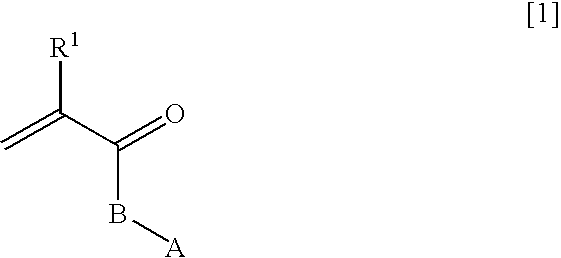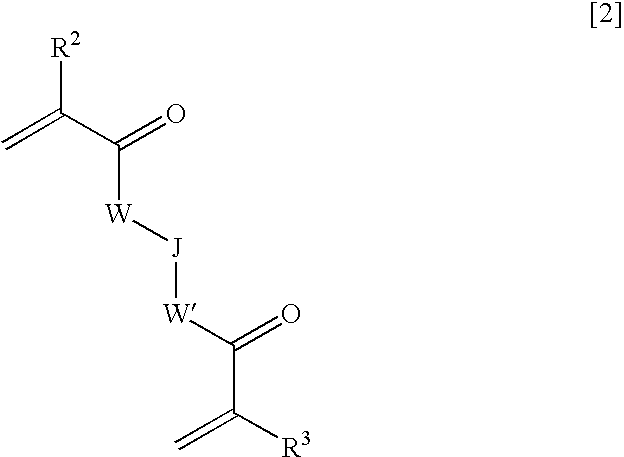Ophthalmic and otorhinolaryngological device materials
a technology of ophthalmology and otorhinolaryngology, which is applied in the field of improved ophthalmology and otorhinolaryngological device materials, can solve the problems of less desirable than other materials, explosive unfolding, and relatively low refractive index of hydrogel materials, and achieves the effects of reducing equilibrium water content, reducing solubility of macromers, and increasing refractive index
- Summary
- Abstract
- Description
- Claims
- Application Information
AI Technical Summary
Benefits of technology
Problems solved by technology
Method used
Image
Examples
example 1
Initiator Synthesis
Esterification of poly(ethylene glycol) (PEG) 1500 with 2-bromoisobutyrate
[0100]
[0101]An oven dried 250 mL three-neck round bottom flask was fitted with 60 mL addition funnel with a N2 inlevoutlet, and a thermometer adapter and glass stopper. The flask was charged with 29.0 g (19.3 mmol) of PEG 1500, 100 mL of anhydrous CH2Cl2 and 3.5 mL (43.2 mmol) of pyridine, and 5 mL (40.5 mmol) of 2-bromoisobutyryl bromide was placed in the addition funnel. The flask was closed and immersed in an ice bath. 2-Bromoisobutyryl bromide was added dropwise to the cooled solution over 20 min period with stirring. The ice bath was removed and the reaction was stirred for 64 h under a N2 blanket. The reaction mixture was filtered and the filtrate was concentrated. The crude product was dissolved in a small amount of CH2Cl2, loaded onto a short basic alumina column and eluted with CH2Cl2. The eluent was collected and the solvent was removed using a rotary evaporator. The resulting soli...
example 2
Initiator Synthesis
[0104]An oven dried 1 L three-neck round bottom flask was fitted with 60 mL addition funnel with a N2 inlet / outlet, and a thermometer adapter and glass stopper. The flask was charged with 102.6 g (51.3 mmol) of PEG 2000, 300 mL of anhydrous CH2Cl2 and 8.5 mL (105.0 mmol) of pyridine, and 13 mL (105.0 mmol) of 2-bromoisobutyryl bromide was placed in the addition funnel. The flask was closed and immersed in an ice bath. 2-Bromoisobutyryl bromide was added dropwise to the cooled solution over 40 min period with stirring. The ice bath was removed and the reaction was stirred for 27 h under a N2 blanket. The reaction mixture was filtered and the filtrate was concentrated. The crude product was dissolved in a small amount of CH2Cl2, loaded onto a short basic alumina column and eluted with CH2Cl2. The eluent was collected and the solvent was removed using a rotary evaporator. The resulting solid was dissolved in CH2Cl2 and precipitated into a large excess of 1 / 1 hexane / d...
example 3
Initiator Synthesis
[0106]An oven dried 500 mL three-neck round bottom flask was fitted with 60 mL addition funnel with a N2 inlet / outlet, and a thermometer adapter and glass stopper. The flask was charged with 44.66 (9.8 mmol) of PEG 4600, 100 mL of anhydrous CH2Cl2 and 2.0 mL (24.7 mmol) of pyridine, and 2.6 mL (20.5 mmol) of 2-bromoisobutyryl bromide was placed in the addition funnel. The flask was closed and immersed in an ice bath. 2-Bromoisobutyryl bromide was added dropwise to the cooled solution over a 20 min period with stirring. The ice bath was removed and the reaction was stirred for 63 h under a N2 blanket. The reaction mixture was filtered and the filtrate was concentrated. The crude product was dissolved in a small amount of CH2Cl2, loaded onto a short basic alumina column and eluted with CH2Cl2. The eluent was collected and the solvent was removed using a rotary evaporator. The resulting solid was dissolved in CH2Cl2 and precipitated into a large excess of 1 / 1 hexane / ...
PUM
| Property | Measurement | Unit |
|---|---|---|
| refractive index | aaaaa | aaaaa |
| glass transition temperature | aaaaa | aaaaa |
| Tg | aaaaa | aaaaa |
Abstract
Description
Claims
Application Information
 Login to View More
Login to View More - Generate Ideas
- Intellectual Property
- Life Sciences
- Materials
- Tech Scout
- Unparalleled Data Quality
- Higher Quality Content
- 60% Fewer Hallucinations
Browse by: Latest US Patents, China's latest patents, Technical Efficacy Thesaurus, Application Domain, Technology Topic, Popular Technical Reports.
© 2025 PatSnap. All rights reserved.Legal|Privacy policy|Modern Slavery Act Transparency Statement|Sitemap|About US| Contact US: help@patsnap.com



